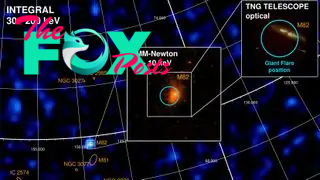Science
Enormous explosion in 'Cigar Galaxy' reveals rare type of star never seen beyond the Milky Way
An ultrabright explosion has led astronomers to find the first magnetic star to be discovered outside the Milky Way — and there could be many more out there.
The newfound magnetar, a dense relic of a once-bright star with a remarkably strong magnetic field, resides in the galaxy M82 (dubbed the Cigar Galaxy), roughly 12 million light-years from Earth. Scientists using a European Space Agency (ESA) telescope spotted the ultramagnetic star after it violently erupted and blasted out intense energy that lasted just a fraction of a second, according to a new study published Wednesday (April 24) in the journal Nature.
Sometimes called the universe's most powerful magnets, magnetars are rapidly spinning, intensely magnetized versions of neutron stars — remnants of supernova explosions — that shine thousands of times brighter than the sun. However, their eruptions are so fleeting and unpredictable that they are tricky targets for astrophysicists to study. Only three other magnetar flares have been recorded in the past 50 years, so the latest find opens the search for more extragalactic magnetars, scientists say.
"If we can find many more, we can start to understand how often these flares happen and how these stars lose energy in the process," Ashley Chrimes, an ESA researcher who wasn't directly involved with the new study, said in a statement.
Related: Bizarre new cosmic object is the most magnetic star in the universe
A star that had a blast

In mid-November 2023, ESA's Integral space telescope flagged a brief, sudden flare of gaMMA-rays in the direction of M82. Similar radiation also blasts out during the births of black holes, mergers of orbiting neutron stars, and other exotic phenomena unrelated to magnetars.
"We immediately realized that this was a special alert," Sandro Mereghetti, a researcher at the National Institute for Astrophysics in Italy and the lead author of the new study, said in the statement. "GaMMA-ray bursts come from far away and anywhere in the sky, but this burst came from a bright nearby galaxy."
-

 Science4d ago
Science4d agoInside Capitol Hill’s Latest UFO Hearings
-

 Science4d ago
Science4d agoYou Won’t Want to Miss the Leonid Meteor Shower. Here’s How and When You Can See It
-

 Science5d ago
Science5d agoHere’s What Trump’s Win Means for NASA
-

 Science1w ago
Science1w agoWhy Risky Wildfire Zones Have Been Increasing Around the World
-

 Science1w ago
Science1w agoIt’s Time to Redefine What a Megafire Is in the Climate Change Era
-

 Science1w ago
Science1w ago4 Astronauts Return to Earth After Being Delayed by Boeing’s Capsule Trouble and Hurricane Milton
-

 Science1w ago
Science1w agoThe Elegance and Awkwardness of NASA’s New Moon Suit, Designed by Axiom and Prada
-

 Science2w ago
Science2w agoSpaceX Launches Its Mega Starship Rocket. This Time, Mechanical Arms Catch It at Landing



























